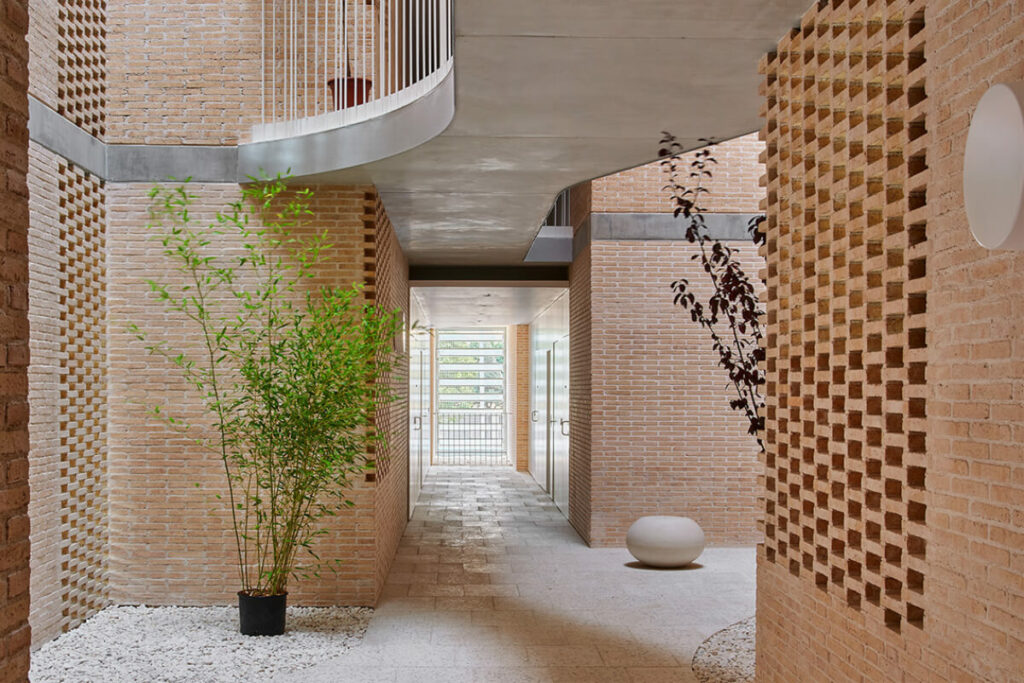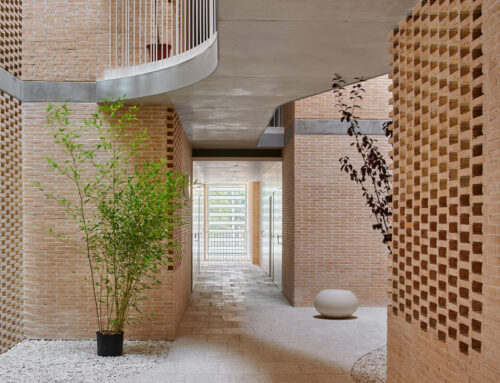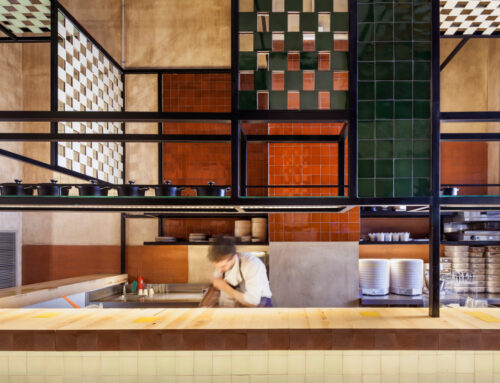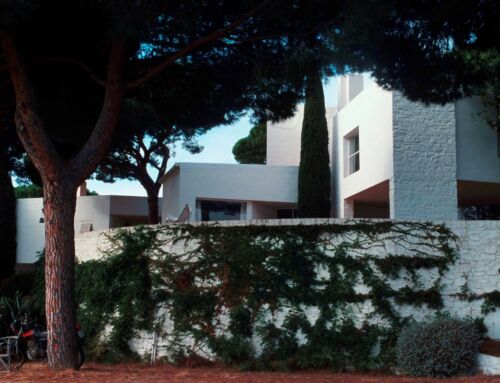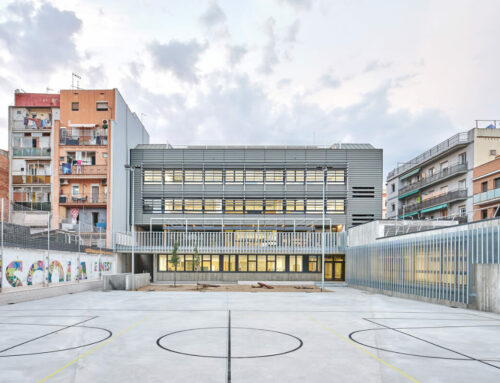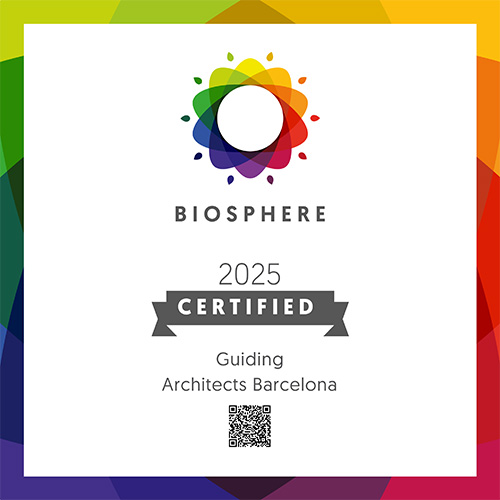Ten Essential Books to Understand Barcelona and Its Architecture
Novels, Essays and Monographs: A Literary Exploration of the City’s Past and Present Urban Identity
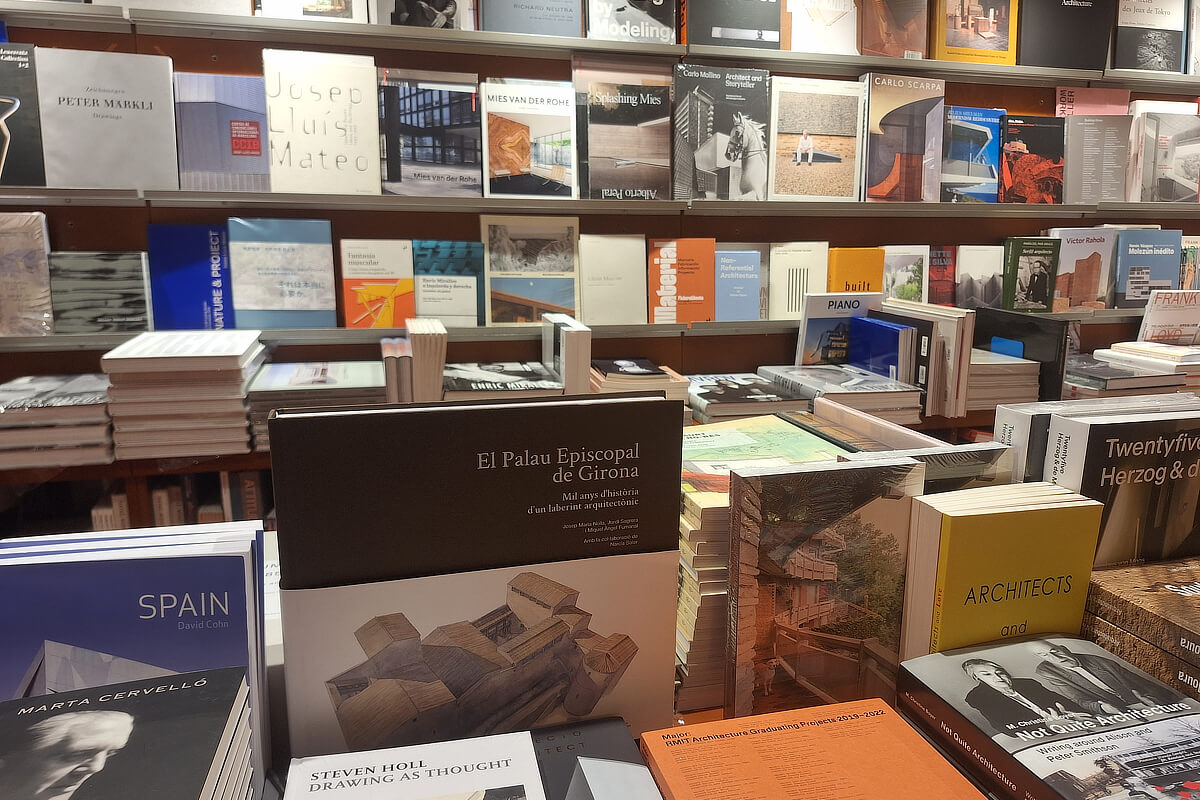
Books on display at La Capell architecture bookstore, © GA Barcelona
Prologue: An Unconditional Endorsement of Books
A book can be many things: a source of knowledge, a stimulus for the imagination, a travel companion or an accomplice in the search for aesthetic pleasure. At a time when the presence of books in our daily lives seems to be in decline, even in areas as unimaginable as universities, at Guiding Architects Barcelona we embrace the upcoming Sant Jordi’s Day as an opportunity to advocate for the fundamental importance that books still have and should continue to have both in Catalan and universal culture.
Sant Jordi, the Festival of Books in Barcelona and the World
Saint George’s Day was not originally related to books. It was a holiday focused on commemorating the patron saint of Catalonia, the mythical knight who killed a dragon to free the inhabitants of a city from its harassment (according to some versions, it was Montblanc in the province of Tarragona). The celebration was formerly focused on the offering of roses, especially from men to women, in reference to the supposed transformation of the dragon’s blood into these flowers.
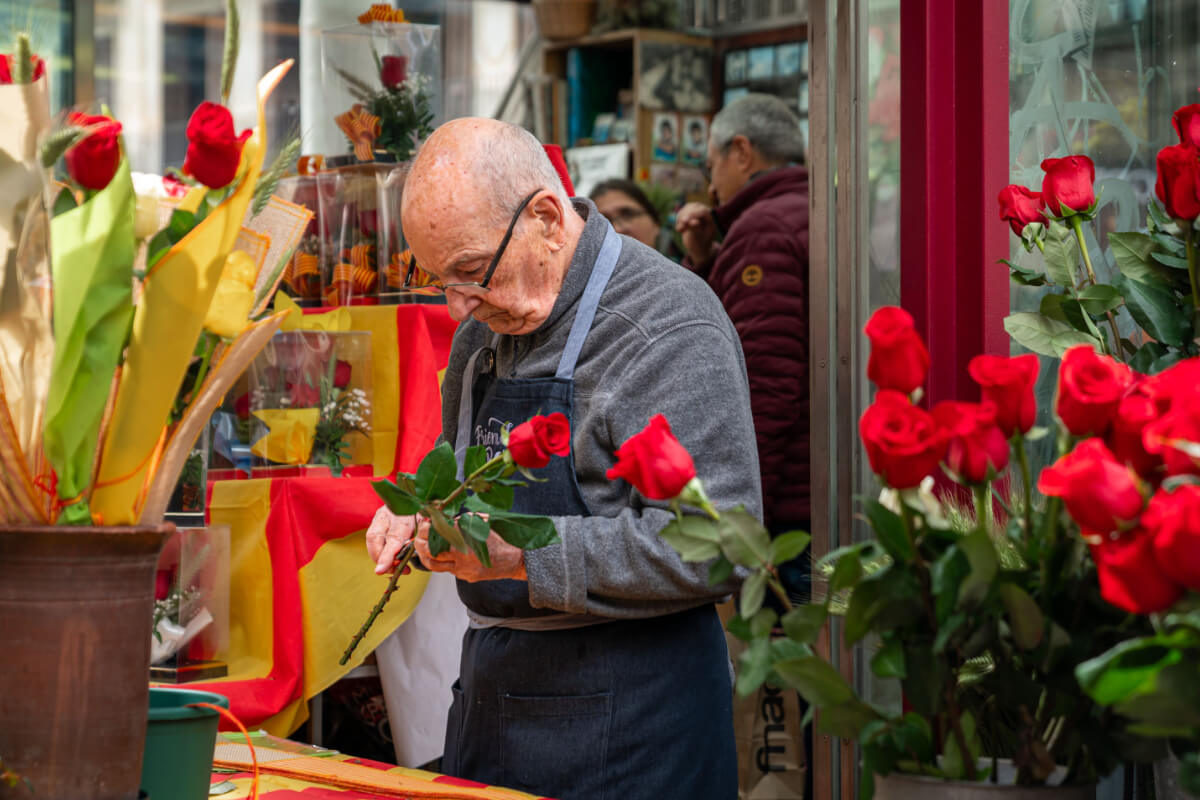
Diada de Sant Jordi 2024, © Júlia Arnau – Ajuntament de Barcelona
On the other hand, in 1926 Vicente Clavel, a Valencian living in Barcelona, proposed the creation of a book day, which was initially celebrated in October and then changed to April 23rd in 1930. The new date was chosen to commemorate the death of Miguel de Cervantes but was merged with the traditional celebration of Sant Jordi, adding the exchange of books to the gifting of roses. The initiative was so successful and had such an impact that UNESCO eventually declared April 23rd as World Book Day.
However, in Catalonia and especially in Barcelona it maintains a unique character; it is one of the most popular local celebrations to this day, with the streets full of stalls and all kinds of literary promotion activities. An appointment definitely recommended for visitors who can fit it into their agendas.
In this spirit, Guiding Architects Barcelona once again proposes a Top Ten, this time dedicated to books about the city. The criteria for making this list have been somewhat heterodox, as we have combined literary works with monographic and essay books; texts on architecture and urban planning but also on history and photography; general works with others that are much more specific and specialized. What they all have in common is that they are documents of great quality in their respective fields, and together they help us discover and understand the essence and architecture of Barcelona.

1. City of Wonders by Eduardo Mendoza (1986). History, Ambition and Satire in Barcelona at the Turn of the Century
Eduardo Mendoza stands out among the writers whose work is closely linked to Barcelona, especially City of Wonders (Ciutat de Barcelona Prize). An exciting historical novel that explains the transformation of the city between the Universal Exhibitions of 1888 and 1929, a particularly attractive period that frames the consolidation of the Eixample urban project and the development of Art Nouveau.
The narrative follows the adventures of Onofre Bouvila, a migrant of modest origins who arrives in the city in search of fortune and manages to prosper thanks to his cunning and meager scruples. The novel combines a historical fresco with picaresque and ironic touches, including a brief but memorable appearance by Antoni Gaudí himself.
To explore Mendoza’s more overtly humorous vein, No Word from Gurb is a good alternative.
2. Cathedral of the Sea by Ildefonso Falcones (2006). A Journey to Medieval Barcelona and the Splendor of Catalan Gothic
Although he does not have the vast literary production of Mendoza, Falcones managed to make a place for himself in the literary collective imagination of the city with his first novel, whose narrative axis is nothing less than the construction of the Santa Maria del Mar church during the fourteenth century. From the start the subject seems attractive to any reader with even the slightest interest in history, but becomes irresistible for architecture aficionados, since we are talking about the undisputed masterpiece of Catalan Gothic.
The novel immerses us in the Middle Ages through the young Arnau Estanyol who works as a bastaix, alternating tasks of unloading ships and transporting stones for the construction of the church. Chance will allow him to change his line of business and attain economic prosperity, although his achievements will provoke the envy of some of his fellow citizens and will be threatened by the Inquisition.
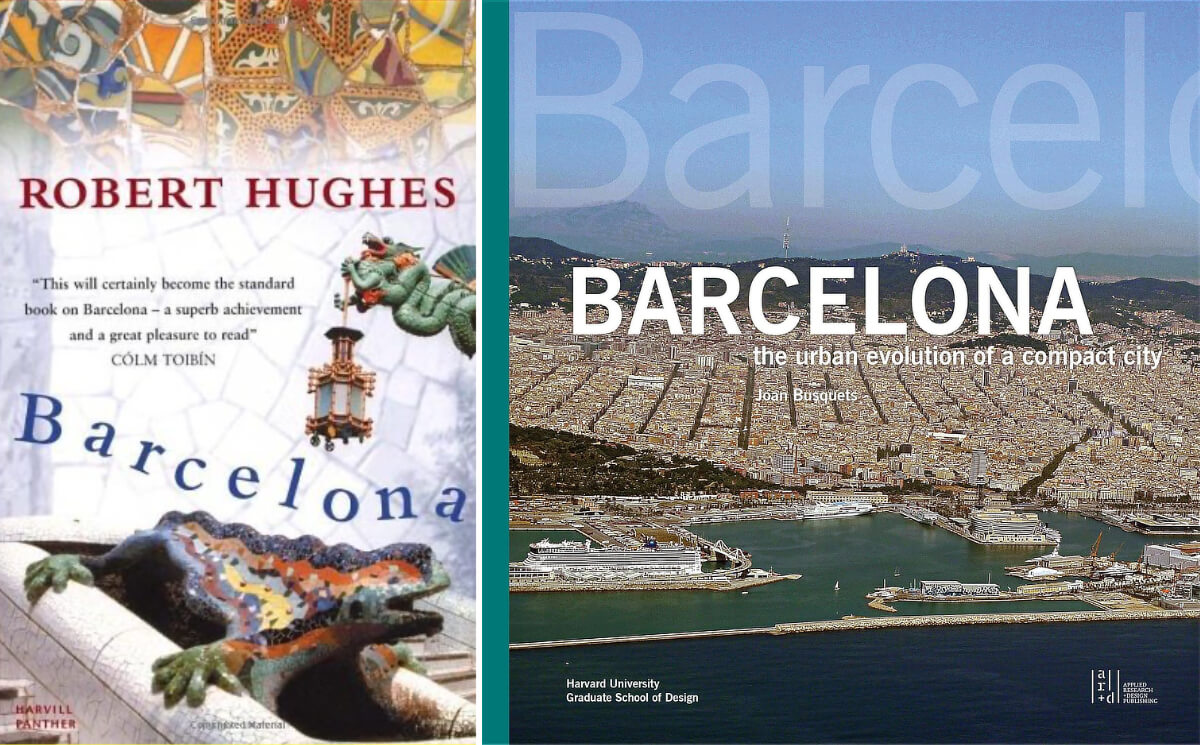
3. Barcelona by Robert Hughes (1992). An Inquisitive Approach to the History and Identity of Barcelona
Sometimes an outside view can be especially objective and enlightening when approaching a situation or a place. Such was George Orwell’s at the time with his Homage to Catalonia, and so is the case of the Australian historian and art critic Robert Hughes. The charismatic author ventures into an attempt to explain the identity of the city and its people while questioning the usual preconceptions.
His polysemic and ironic narration moves between history and sociology, dealing with subjects as dissimilar as art, politics, language, landscape and, of course, architecture. All these ingredients converge in a surprising and essential work that maintains the usual accessibility of Hughes’ prose and has awakened the admiration of readers, writers and architects alike.
Despite the time elapsed since its publication, this is still the best option to understand the essence of Barcelona through a single book.
4. Barcelona: The Urban Evolution of a Compact City by Joan Busquets (2004). The Urban Transformation of Barcelona From the Roman Empire to the 21st Century
Barcelona’s urban evolution throughout history is one of the most unique aspects of the city. From the Roman foundation, through the prosperity of the medieval port, the expansion project of Ildefons Cerdà and the Olympic transformation, Barcelona is a master class in the history of urban planning.
Prominent architect, professor and urban planner Joan Busquets embarks in this book on an exhaustive study of this evolution, from its origins to the beginning of the 21st century, identifying the most relevant and innovative moments. Busquets considers the diverse scales of intervention to explain the achievements and contradictions of Barcelona, without neglecting the less remarkable historical stages.
The result is a very complete document, essential for understanding Barcelona’s shift through successive models of city. Another notable book with a similar theme is Ten Lessons on Barcelona (1985) by Manuel de Solà-Morales.

5. Fin De Siecle Architecture in Barcelona by Ignasi de Solà-Morales (1992). An Architectural and Contextual Analysis of Catalan Art Nouveau
The legacy of Catalan Art Nouveau, known as Modernismo, is not limited to the magnificent work of Antoni Gaudí. Emerging in the late 19th century, it is one of the most vibrant and distinctive architectural styles in Barcelona’s history, and this canonical book by architect, historian and professor Ignasi de Solà-Morales remains one of the best monographs on the subject.
The text analyzes architectural production within the framework of the Renaixença, a Catalan cultural movement with a strong identity claim. But it also assesses the economic, social and urban context in a period of great changes that in many aspects defined the character of Barcelona.
The analysis of the buildings contemplates their tectonic, aesthetic and symbolic aspects, as well as their relationship with the European architecture of the period. There is no doubt about the academic vocation of this book by Solà-Morales, but it is an accessible and fundamental work to understand this unique architectural movement.
6. Antoni Gaudí: Ornament, Fire and Ashes by Juan José Lahuerta (2016). A Critical and Contextualized Analysis of Gaudí, His Work and His Image
This selection could not be missing a book dedicated to Antoni Gaudí and we have chosen Antoni Gaudí: Ornament, Fire and Ashes, a work that is more essayistic than monographic. Written by Juan José Lahuerta, one of the leading experts on the Art Nouveau architect and current director of the Gaudí Chair, the text questions some of the most recurrent myths, such as the one that describes Gaudí as a misunderstood genius, almost isolated from reality.
Lahuerta places great emphasis on his relationship with the context, on the one hand to explain that Gaudí was totally immersed in the architectural theory and praxis of his time and then to emphasize the historical conditioning factors of his production, such as the social conflicts of the late nineteenth century.
The book also addresses little-studied aspects such as the industrial processes he used to create ornamental elements or the crucial role of the printed media in the dissemination of his architecture and the consolidation of his public image.
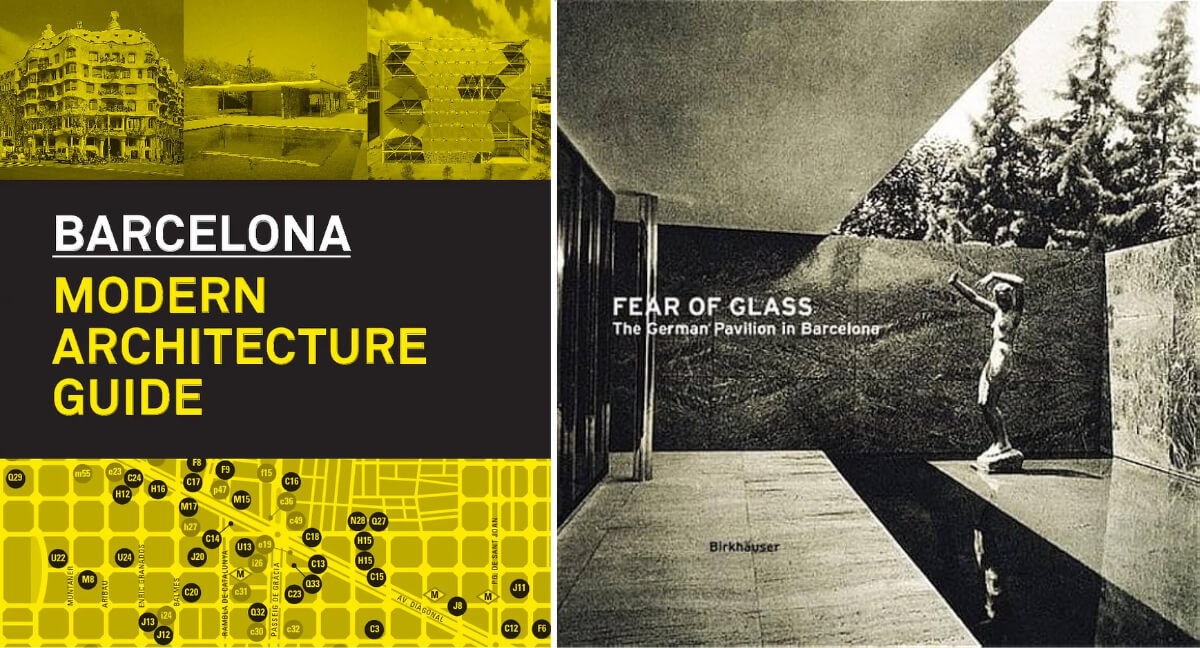
7. Barcelona: Modern Architecture Guide by Gausa, Cervelló and Pla (2002). An Architectural Mapping of Modernism in Barcelona
Architecture guides are especially useful for locating and visiting works of modern and contemporary architecture, as these often occupy a residual space in conventional guidebooks. Hence the importance of this document by Manuel Gausa, Marta Cervelló and Maurici Pla, three renowned architects with an academic profile.
The chronological spectrum of the book spans from Art Nouveau to the beginning of the 21st century, including the rationalist works of the GATCPAC, those of the R Group and the emblematic projects of the Olympic transformation of Barcelona. The authors do not limit themselves to selecting and compiling buildings but organize and present them from a critical perspective with the idea of structuring a discourse.
As is usual in this type of work, the descriptions are accompanied by photographs and plans, and more recent projects were added in the updated 2013 reprint.
8. Fear of Glass by Josep Quetglas (2001). A Suggestive Reinterpretation of Mies Van Der Rohe’s Pavilion
Thanks to his unique didactic talent, but above all to a set of texts as dazzling as they are provocative, Josep Quetglas has been for decades an admired and controversial reference in Barcelona’s architectural academia. Among his works we highlight Fear of Glass: The German Pavilion in Barcelona, a clear-sighted and demystifying text that addresses the only building by Ludwig Mies van de Rohe in Barcelona and indirectly its reconstruction.
From the outset, Quetglas proposes a layout based on a theatrical piece, something quite unusual for a history of architecture text. The discourse, which combines academic rigor with philosophical and poetic nuances, vindicates the unrepeatable nature of the original 1929 building and explores some of the pavilion’s less evident characteristics, such as its inspiration in Greek temples or the prominence of reflections as a compositional and tectonic resource.
The 2020 reprint in Spanish includes a new prologue and additional texts.
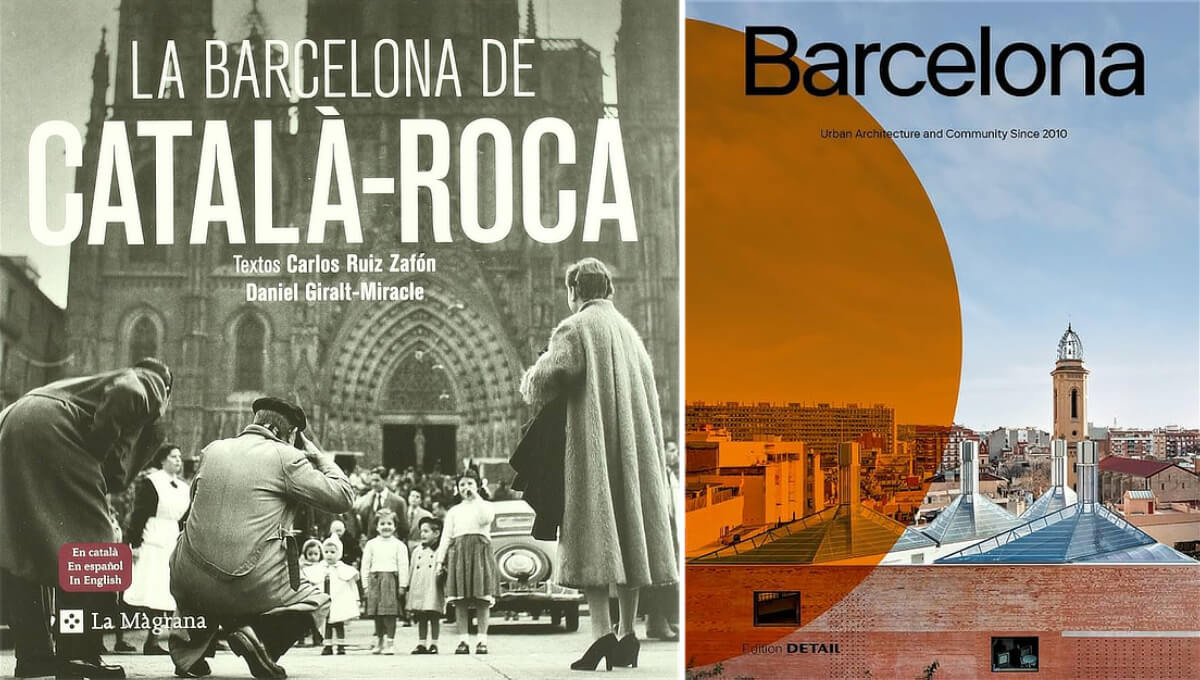
9. La Barcelona de Català-Roca by Carlos Ruiz Zafón and Daniel Giralt-Miracle (2008). Barcelona and Its Architecture Captured by the Lens of the Great Photographer
Francesc Català-Roca holds a place of honor among the great Catalan photographers and his work resonates with echoes of Henri Cartier-Bresson, both for his humanistic gaze and his precise sense of aesthetics. If we add to this the fact that he was especially devoted to portraying the architecture of Barcelona, it is easy to understand why this book is included in our selection.
It should come as no surprise, then, that the Architects’ Association of Catalonia has a special section dedicated to Català-Roca’s work in its archives. This volume highlights the photographer’s close ties to Barcelona by presenting a wide sample of images taken over the course of fifty years.
Organized into thematic chapters, the photos are accompanied with texts by writer Carlos Ruiz Zafón and art historian Daniel Giralt-Miracle. A fascinating visual journey through 20th century Barcelona.
10. Barcelona. Urban Architecture and Community Since 2010 Edited by Wessely and Hofmeister (2023). Projects, Tendencies and Voices of Recent Architecture in Barcelona
This book that brings together the best projects of the last 15 years is an excellent option to delve into the most recent architectural production in Barcelona. Edited by Heide Wessely and Sandra Hofmeister, the compilation is organized into three functional categories: community spaces, culture and education, and housing.
In addition, it alternates the presentation of selected buildings with interviews to leading architects and essays by various authors, including Lorenzo Kárász of Guiding Architects Barcelona. The format lends itself particularly well to highlighting the most important trends among today’s architects from a variety of perspectives.
These include the transformation of public space, the sustainability of buildings, the sense of community and the importance of recycling, particularly of industrial buildings. This exquisitely presented book is a must for understanding present-day Barcelona and its architecture.
Epilogue: Closing the Book to Start the Journey
As in our previous top ten it will be impossible to please everyone. Nor do we pretend to say that these books are the ten best written or the ten most original. They are simply ten thresholds that Guiding Architects Barcelona proposes to get into the heart of the city and discover more about its history and architecture.
Ten books that we believe will be as attractive for visitors as for residents and will lead to a better understanding of Barcelona, either through fiction or via scholarly reflection. Some covering general issues, others touching on several themes simultaneously and yet some others focused on very specific topics, but all sharing that suggestive capacity that good books have.
If you are lucky enough to be in Barcelona, enjoy the Diada de Sant Jordi, and if you take the opportunity to buy or give books, you already have some more options to choose from. Happy World Book Day!
Text: Pedro Capriata
BIBLIOGRAPHY
Busquets, J. (2004). Barcelona. La construcción urbanística de una ciudad compacta. Ediciones del Serbal.
Falcones, I. (2011). La Catedral del Mar. Debolsillo.
Gausa M., Cervelló, M. and Pla, M. (2013). Barcelona: Guía de Arquitectura Moderna. Actar.
Hughes, R. (2006). Barcelona. Anagrama.
Lahuerta, J. J. (2016). Antoni Gaudí: Fuego y cenizas. Tenov.
Lahuerta, J. J. (2021). Gaudí. Museu Nacional d’Art de Catalunya.
Mendoza, E. (2022). La ciudad de los prodigios. Austral.
Mendoza, E. (2011). Sin noticias de Gurb. Seix Barral.
Orwell, G (2000). Homage to Catalonia. Penguin Classics.
Quetglas, J (2020). El horror cristalizado: Imágenes del Pabellón de Alemania de Mies van der Rohe. Ediciones Asimétricas.
Ruiz Zafón, C. and Giralt-Miracle, D. (2008). La Barcelona de Català-Roca. RBA Libros.
Solà-Morales, I. (1992). Arquitectura modernista: fi de segle a Barcelona. Gustavo Gili.
Solà-Morales, M. (2009). Deu Lliçons sobre Barcelona. Col·legi d’Arquitectes de Catalunya.
Wessely, H. and Hofmeister, S. (Ed.) (2023) Barcelona. Urban Architecture and Community since 2010. Edition Detail.
Ten Essential Books to Understand Barcelona and Its Architecture
Novels, Essays and Monographs: A Literary Exploration of the City’s Past and Present Urban Identity

Books on display at La Capell architecture bookstore, © GA Barcelona
Prologue: An Unconditional Endorsement of Books
A book can be many things: a source of knowledge, a stimulus for the imagination, a travel companion or an accomplice in the search for aesthetic pleasure. At a time when the presence of books in our daily lives seems to be in decline, even in areas as unimaginable as universities, at Guiding Architects Barcelona we embrace the upcoming Sant Jordi’s Day as an opportunity to advocate for the fundamental importance that books still have and should continue to have both in Catalan and universal culture.
Sant Jordi, the Festival of Books in Barcelona and the World
Saint George’s Day was not originally related to books. It was a holiday focused on commemorating the patron saint of Catalonia, the mythical knight who killed a dragon to free the inhabitants of a city from its harassment (according to some versions, it was Montblanc in the province of Tarragona). The celebration was formerly focused on the offering of roses, especially from men to women, in reference to the supposed transformation of the dragon’s blood into these flowers.

Diada de Sant Jordi 2024, © Júlia Arnau – Ajuntament de Barcelona
On the other hand, in 1926 Vicente Clavel, a Valencian living in Barcelona, proposed the creation of a book day, which was initially celebrated in October and then changed to April 23rd in 1930. The new date was chosen to commemorate the death of Miguel de Cervantes but was merged with the traditional celebration of Sant Jordi, adding the exchange of books to the gifting of roses. The initiative was so successful and had such an impact that UNESCO eventually declared April 23rd as World Book Day.
However, in Catalonia and especially in Barcelona it maintains a unique character; it is one of the most popular local celebrations to this day, with the streets full of stalls and all kinds of literary promotion activities. An appointment definitely recommended for visitors who can fit it into their agendas.
In this spirit, Guiding Architects Barcelona once again proposes a Top Ten, this time dedicated to books about the city. The criteria for making this list have been somewhat heterodox, as we have combined literary works with monographic and essay books; texts on architecture and urban planning but also on history and photography; general works with others that are much more specific and specialized. What they all have in common is that they are documents of great quality in their respective fields, and together they help us discover and understand the essence and architecture of Barcelona.

1. City of Wonders by Eduardo Mendoza (1986). History, Ambition and Satire in Barcelona at the Turn of the Century
Eduardo Mendoza stands out among the writers whose work is closely linked to Barcelona, especially City of Wonders (Ciutat de Barcelona Prize). An exciting historical novel that explains the transformation of the city between the Universal Exhibitions of 1888 and 1929, a particularly attractive period that frames the consolidation of the Eixample urban project and the development of Art Nouveau.
The narrative follows the adventures of Onofre Bouvila, a migrant of modest origins who arrives in the city in search of fortune and manages to prosper thanks to his cunning and meager scruples. The novel combines a historical fresco with picaresque and ironic touches, including a brief but memorable appearance by Antoni Gaudí himself.
To explore Mendoza’s more overtly humorous vein, No Word from Gurb is a good alternative.
2. Cathedral of the Sea by Ildefonso Falcones (2006). A Journey to Medieval Barcelona and the Splendor of Catalan Gothic
Although he does not have the vast literary production of Mendoza, Falcones managed to make a place for himself in the literary collective imagination of the city with his first novel, whose narrative axis is nothing less than the construction of the Santa Maria del Mar church during the fourteenth century. From the start the subject seems attractive to any reader with even the slightest interest in history, but becomes irresistible for architecture aficionados, since we are talking about the undisputed masterpiece of Catalan Gothic.
The novel immerses us in the Middle Ages through the young Arnau Estanyol who works as a bastaix, alternating tasks of unloading ships and transporting stones for the construction of the church. Chance will allow him to change his line of business and attain economic prosperity, although his achievements will provoke the envy of some of his fellow citizens and will be threatened by the Inquisition.

3. Barcelona by Robert Hughes (1992). An Inquisitive Approach to the History and Identity of Barcelona
Sometimes an outside view can be especially objective and enlightening when approaching a situation or a place. Such was George Orwell’s at the time with his Homage to Catalonia, and so is the case of the Australian historian and art critic Robert Hughes. The charismatic author ventures into an attempt to explain the identity of the city and its people while questioning the usual preconceptions.
His polysemic and ironic narration moves between history and sociology, dealing with subjects as dissimilar as art, politics, language, landscape and, of course, architecture. All these ingredients converge in a surprising and essential work that maintains the usual accessibility of Hughes’ prose and has awakened the admiration of readers, writers and architects alike.
Despite the time elapsed since its publication, this is still the best option to understand the essence of Barcelona through a single book.
4. Barcelona: The Urban Evolution of a Compact City by Joan Busquets (2004). The Urban Transformation of Barcelona From the Roman Empire to the 21st Century
Barcelona’s urban evolution throughout history is one of the most unique aspects of the city. From the Roman foundation, through the prosperity of the medieval port, the expansion project of Ildefons Cerdà and the Olympic transformation, Barcelona is a master class in the history of urban planning.
Prominent architect, professor and urban planner Joan Busquets embarks in this book on an exhaustive study of this evolution, from its origins to the beginning of the 21st century, identifying the most relevant and innovative moments. Busquets considers the diverse scales of intervention to explain the achievements and contradictions of Barcelona, without neglecting the less remarkable historical stages.
The result is a very complete document, essential for understanding Barcelona’s shift through successive models of city. Another notable book with a similar theme is Ten Lessons on Barcelona (1985) by Manuel de Solà-Morales.

5. Fin De Siecle Architecture in Barcelona by Ignasi de Solà-Morales (1992). An Architectural and Contextual Analysis of Catalan Art Nouveau
The legacy of Catalan Art Nouveau, known as Modernismo, is not limited to the magnificent work of Antoni Gaudí. Emerging in the late 19th century, it is one of the most vibrant and distinctive architectural styles in Barcelona’s history, and this canonical book by architect, historian and professor Ignasi de Solà-Morales remains one of the best monographs on the subject.
The text analyzes architectural production within the framework of the Renaixença, a Catalan cultural movement with a strong identity claim. But it also assesses the economic, social and urban context in a period of great changes that in many aspects defined the character of Barcelona.
The analysis of the buildings contemplates their tectonic, aesthetic and symbolic aspects, as well as their relationship with the European architecture of the period. There is no doubt about the academic vocation of this book by Solà-Morales, but it is an accessible and fundamental work to understand this unique architectural movement.
6. Antoni Gaudí: Ornament, Fire and Ashes by Juan José Lahuerta (2016). A Critical and Contextualized Analysis of Gaudí, His Work and His Image
This selection could not be missing a book dedicated to Antoni Gaudí and we have chosen Antoni Gaudí: Ornament, Fire and Ashes, a work that is more essayistic than monographic. Written by Juan José Lahuerta, one of the leading experts on the Art Nouveau architect and current director of the Gaudí Chair, the text questions some of the most recurrent myths, such as the one that describes Gaudí as a misunderstood genius, almost isolated from reality.
Lahuerta places great emphasis on his relationship with the context, on the one hand to explain that Gaudí was totally immersed in the architectural theory and praxis of his time and then to emphasize the historical conditioning factors of his production, such as the social conflicts of the late nineteenth century.
The book also addresses little-studied aspects such as the industrial processes he used to create ornamental elements or the crucial role of the printed media in the dissemination of his architecture and the consolidation of his public image.

7. Barcelona: Modern Architecture Guide by Gausa, Cervelló and Pla (2002). An Architectural Mapping of Modernism in Barcelona
Architecture guides are especially useful for locating and visiting works of modern and contemporary architecture, as these often occupy a residual space in conventional guidebooks. Hence the importance of this document by Manuel Gausa, Marta Cervelló and Maurici Pla, three renowned architects with an academic profile.
The chronological spectrum of the book spans from Art Nouveau to the beginning of the 21st century, including the rationalist works of the GATCPAC, those of the R Group and the emblematic projects of the Olympic transformation of Barcelona. The authors do not limit themselves to selecting and compiling buildings but organize and present them from a critical perspective with the idea of structuring a discourse.
As is usual in this type of work, the descriptions are accompanied by photographs and plans, and more recent projects were added in the updated 2013 reprint.
8. Fear of Glass by Josep Quetglas (2001). A Suggestive Reinterpretation of Mies Van Der Rohe’s Pavilion
Thanks to his unique didactic talent, but above all to a set of texts as dazzling as they are provocative, Josep Quetglas has been for decades an admired and controversial reference in Barcelona’s architectural academia. Among his works we highlight Fear of Glass: The German Pavilion in Barcelona, a clear-sighted and demystifying text that addresses the only building by Ludwig Mies van de Rohe in Barcelona and indirectly its reconstruction.
From the outset, Quetglas proposes a layout based on a theatrical piece, something quite unusual for a history of architecture text. The discourse, which combines academic rigor with philosophical and poetic nuances, vindicates the unrepeatable nature of the original 1929 building and explores some of the pavilion’s less evident characteristics, such as its inspiration in Greek temples or the prominence of reflections as a compositional and tectonic resource.
The 2020 reprint in Spanish includes a new prologue and additional texts.

9. La Barcelona de Català-Roca by Carlos Ruiz Zafón and Daniel Giralt-Miracle (2008). Barcelona and Its Architecture Captured by the Lens of the Great Photographer
Francesc Català-Roca holds a place of honor among the great Catalan photographers and his work resonates with echoes of Henri Cartier-Bresson, both for his humanistic gaze and his precise sense of aesthetics. If we add to this the fact that he was especially devoted to portraying the architecture of Barcelona, it is easy to understand why this book is included in our selection.
It should come as no surprise, then, that the Architects’ Association of Catalonia has a special section dedicated to Català-Roca’s work in its archives. This volume highlights the photographer’s close ties to Barcelona by presenting a wide sample of images taken over the course of fifty years.
Organized into thematic chapters, the photos are accompanied with texts by writer Carlos Ruiz Zafón and art historian Daniel Giralt-Miracle. A fascinating visual journey through 20th century Barcelona.
10. Barcelona. Urban Architecture and Community Since 2010 Edited by Wessely and Hofmeister (2023). Projects, Tendencies and Voices of Recent Architecture in Barcelona
This book that brings together the best projects of the last 15 years is an excellent option to delve into the most recent architectural production in Barcelona. Edited by Heide Wessely and Sandra Hofmeister, the compilation is organized into three functional categories: community spaces, culture and education, and housing.
In addition, it alternates the presentation of selected buildings with interviews to leading architects and essays by various authors, including Lorenzo Kárász of Guiding Architects Barcelona. The format lends itself particularly well to highlighting the most important trends among today’s architects from a variety of perspectives.
These include the transformation of public space, the sustainability of buildings, the sense of community and the importance of recycling, particularly of industrial buildings. This exquisitely presented book is a must for understanding present-day Barcelona and its architecture.
Epilogue: Closing the Book to Start the Journey
As in our previous top ten it will be impossible to please everyone. Nor do we pretend to say that these books are the ten best written or the ten most original. They are simply ten thresholds that Guiding Architects Barcelona proposes to get into the heart of the city and discover more about its history and architecture.
Ten books that we believe will be as attractive for visitors as for residents and will lead to a better understanding of Barcelona, either through fiction or via scholarly reflection. Some covering general issues, others touching on several themes simultaneously and yet some others focused on very specific topics, but all sharing that suggestive capacity that good books have.
If you are lucky enough to be in Barcelona, enjoy the Diada de Sant Jordi, and if you take the opportunity to buy or give books, you already have some more options to choose from. Happy World Book Day!
Text: Pedro Capriata
BIBLIOGRAPHY
Busquets, J. (2004). Barcelona. La construcción urbanística de una ciudad compacta. Ediciones del Serbal.
Falcones, I. (2011). La Catedral del Mar. Debolsillo.
Gausa M., Cervelló, M. and Pla, M. (2013). Barcelona: Guía de Arquitectura Moderna. Actar.
Hughes, R. (2006). Barcelona. Anagrama.
Lahuerta, J. J. (2016). Antoni Gaudí: Fuego y cenizas. Tenov.
Lahuerta, J. J. (2021). Gaudí. Museu Nacional d’Art de Catalunya.
Mendoza, E. (2022). La ciudad de los prodigios. Austral.
Mendoza, E. (2011). Sin noticias de Gurb. Seix Barral.
Orwell, G (2000). Homage to Catalonia. Penguin Classics.
Quetglas, J (2020). El horror cristalizado: Imágenes del Pabellón de Alemania de Mies van der Rohe. Ediciones Asimétricas.
Ruiz Zafón, C. and Giralt-Miracle, D. (2008). La Barcelona de Català-Roca. RBA Libros.
Solà-Morales, I. (1992). Arquitectura modernista: fi de segle a Barcelona. Gustavo Gili.
Solà-Morales, M. (2009). Deu Lliçons sobre Barcelona. Col·legi d’Arquitectes de Catalunya.
Wessely, H. and Hofmeister, S. (Ed.) (2023) Barcelona. Urban Architecture and Community since 2010. Edition Detail.




